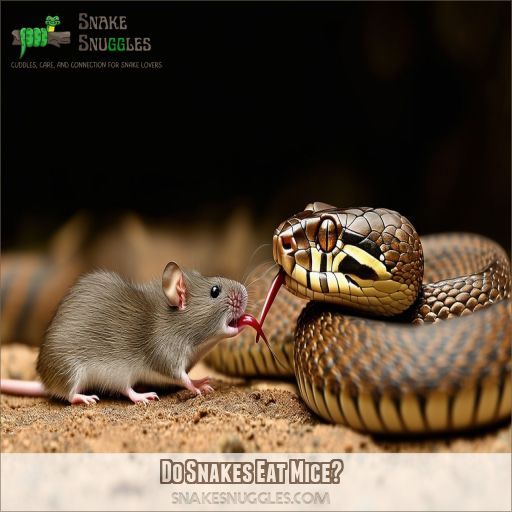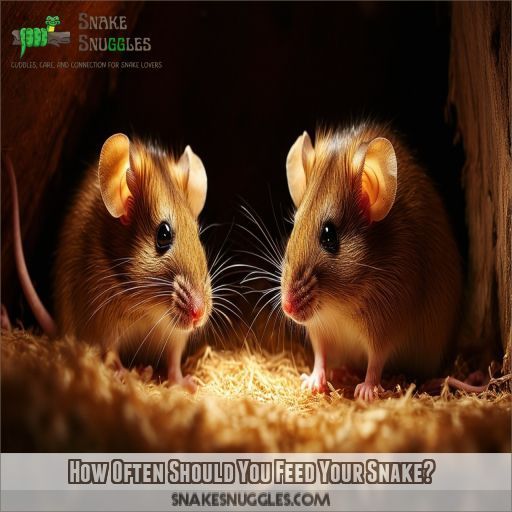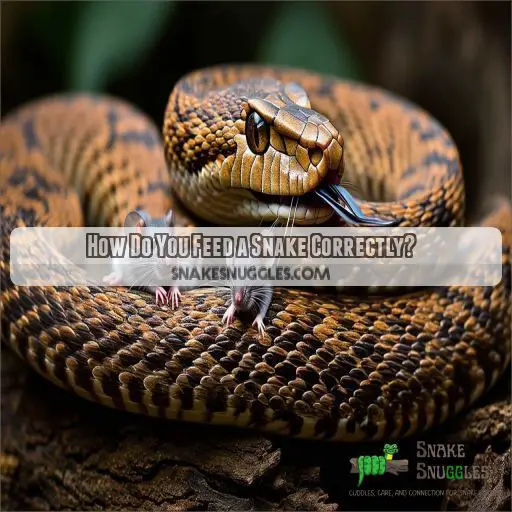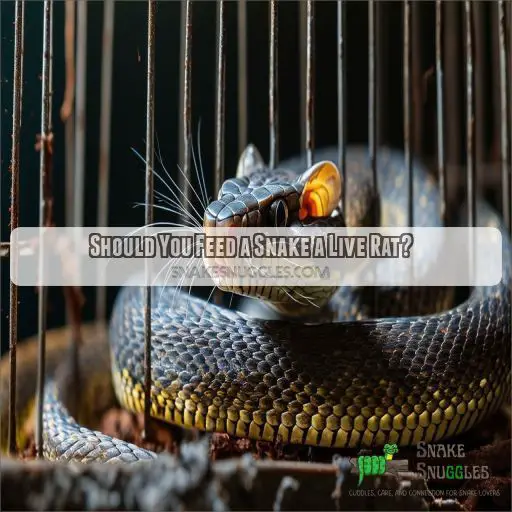This site is supported by our readers. We may earn a commission, at no cost to you, if you purchase through links.
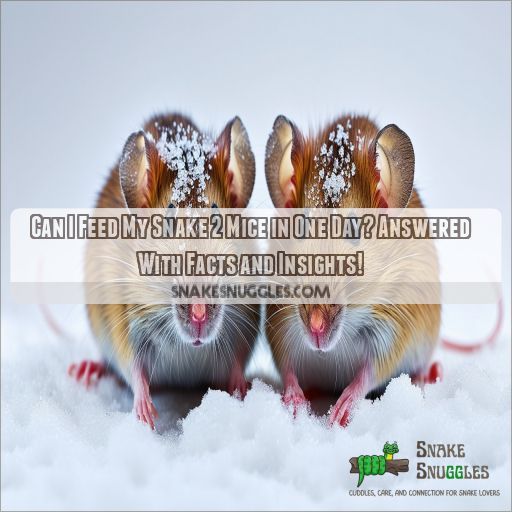 Yes, you can feed your snake two mice in one day, but it’s important to do it correctly. Make sure the total prey size doesn’t exceed 10% of your snake’s body weight.
Yes, you can feed your snake two mice in one day, but it’s important to do it correctly. Make sure the total prey size doesn’t exceed 10% of your snake’s body weight.
Offer the second mouse 10-15 minutes after the first, and monitor your snake to avoid overfeeding. Younger and smaller snakes may need more frequent meals whereas larger or adult snakes often need less.
Using frozen-thawed prey is safer.
Curious about the best practices for feeding your snake and adjusting schedules based on its size and age? Stick around to learn the details!
Table Of Contents
- Key Takeaways
- Can I Feed My Snake 2 Mice in One Day Answered?
- Can Snakes Eat Two Mice in One Day?
- How Long Should You Wait Between Feedings?
- How Many Mice Can a Snake Eat a Day?
- Do Snakes Eat Mice?
- How Often Should You Feed Your Snake?
- How Much Food Should a Snake Eat a Day?
- How Do You Feed a Snake Correctly?
- Should You Feed a Snake a Live Rat?
- Frequently Asked Questions (FAQs)
- Can my snake eat two mice in one day?
- How long should you wait between feeding snakes?
- Can you feed a ball python twice in one day?
- What happens if you feed a snake a mouse too big?
- How many mice can a snake eat a day?
- Do snakes eat mice?
- How often should I Feed my snake?
- How much food should a snake eat a day?
- How do you feed a snake correctly?
- Should you feed a snake a live rat?
- How do snakes digest their prey?
- Can overfeeding shorten a snakes lifespan?
- What signs indicate a snake is full?
- Are specific prey types better for digestion?
- How does prey size affect snake health?
- Conclusion
Key Takeaways
4 Need-to-Knows About Feeding Your Snake Two Mice a Day
- Split the Meal: Treat your snake to two mice a day, but make sure they’re not too big! Keep it under 10% of their weight, like a tiny sliver of pizza.
- Time it Right: Give your snake a 10-15 minute break between mice. They need time to digest the first one before they tackle the second.
- Monitor Munching: Keep an eye on your snake after they eat. If they’re not into the second mouse, don’t force it. They’re probably full, like a satisfied kitty after a bowl of milk.
- Frozen is Best: Skip the live prey and go for frozen-thawed mice instead. It’s safer for your snake and less stressful for you. Plus, they’re like tiny frozen treats for your scaly friend!
Can I Feed My Snake 2 Mice in One Day Answered?
Yes, you can feed your snake 2 mice in one day if it weighs more than 500 grams, but it’s important to monitor for signs of overfeeding and verify proper digestion (Source). Factors such as the size and age of the snake should also be considered to avoid health issues (Source).
Can Snakes Eat Two Mice in One Day?
Can snakes eat two mice in one day? Of course! Many snakes, like ball pythons and corn snakes, can handle multiple meals if they’re still hungry after the first mouse.
The key is making sure the total prey size doesn’t exceed 10% of the snake’s body weight. Keeping an eye on feeding frequency is essential.
When offering two mice, make sure each mouse is appropriately sized – around or slightly smaller than the snake’s head. Using frozen-thawed prey is recommended to avoid live prey risks and potential injuries.
This feeding technique can boost the snake’s nutritional intake and overall well-being. Remember, though, every snake’s appetite varies, so monitor your snake’s response carefully.
How Long Should You Wait Between Feedings?
When feeding your snake, it’s crucial to observe its response and allow an adequate interval between feedings to prevent overfeeding. Factors such as the snake’s age, size, and dietary requirements influence feeding frequency and should guide your strategy.
Factors Affecting Feeding Frequency
When determining the feeding frequency for your snake, consider several factors:
- Snake’s age: Younger snakes often eat more frequently.
- Snake’s size: Larger snakes may not need as frequent feedings.
- Prey size: Small prey requires more frequent feeding.
- Prey type: Nutritional differences matter.
- Boa’s weight and age: Tailor feeding to individual needs.
Monitoring Snake’s Response
After feeding the first mouse, wait about 10-15 minutes before offering the second. Monitor your snake’s feeding response carefully to avoid overfeeding. Make certain the prey is appropriately sized and digested adequately. Watch for signs like regurgitation or reluctance to eat, as these can indicate issues with feeding frequency or nutritional adequacy.
How Many Mice Can a Snake Eat a Day?
The number of mice your snake can eat in a day depends on its size, age, and nutritional needs. It’s important to balance feeding frequency and prey size to make sure your snake remains healthy without overfeeding.
Factors Affecting Prey Size
Factors affecting prey size include:
- Prey availability: Make sure a steady supply of appropriate-sized prey.
- Snake activity: Active snakes might need more frequent feedings.
- Prey size variation: Adjust feeding based on the prey item’s size and the snake’s needs.
Adapt your feed schedule to prevent the snake from becoming overweight. Corn snakes and boa constrictors have different feeding preferences.
Nutritional Value of Prey
Feeding your snake two mice a day depends on their nutritional value. Mice offer balanced nutrients, but frequent overfeeding can cause weight gain. Proper feeding ensures proper nutrient density and accommodates seasonal changes like winter and summer.
| Criteria | Small Mouse | Medium Mouse |
|---|---|---|
| Average Weight (g) | 30-35 | 40-50 |
| Nutrient Density | Moderate | High |
| Suitable for Age | Young | Adult |
Adjust portion size and frequency for your snake’s age and growth.
Do Snakes Eat Mice?
In the wild, snakes naturally hunt and eat mice as a primary food source. In captivity, you can feed your snake mice to mimic its natural diet and meet its nutritional needs, but feeding your snake frozen mice is the safest and healthiest option.
.
Natural Prey in the Wild
In the wild, snakes primarily hunt and consume small rodents like mice, voles, and shrews. Their hunting habits are driven by their habitat selection, prey availability, and territorial needs. Snakes use a combination of sensory cues, including heat-sensing pits and chemical detection, to locate and capture their prey. Their prey selection is influenced by factors like size, accessibility, and nutritional value.
- Snakes are opportunistic hunters, adapting their feeding behaviors to their environment.
- They may regurgitate prey if it’s too large or difficult to swallow.
- Snakes exhibit seasonal variations in their feeding patterns, often eating less during colder months.
Feeding in Captivity
Feeding in captivity requires understanding your snake’s needs. Mice are common prey, but don’t overfeed.
| Feeding Techniques | Ethical Concerns |
|---|---|
| Use frozen-thawed | Avoid live prey |
| Properly size prey | Prevent injuries |
| Nutritional Supplements | Enclosure Design |
| ————————- | ——————— |
| Maintain balanced diet | Mimic natural habitat |
How Often Should You Feed Your Snake?
Feeding schedules for your snake depend on its age and size. Younger, smaller snakes typically need to eat more frequently, while older, larger snakes can be fed less often.
Age-Based Feeding Schedules
Regarding age-based feeding schedules, young snakes usually require more frequent meals to support their growth. Feed hatchlings every 5-6 days. As they age and their metabolism stabilizes, you can extend the intervals. Adult snakes generally thrive on a weekly feeding routine, ensuring they maintain a healthy weight and meet their appetite.
Size-Based Feeding Schedules
Size-based feeding schedules consider your snake’s length and weight. Adjusting as they grow guarantees proper nutrition and weight gain. Here’s how:
- Small to Medium Snakes: Feed appropriately sized prey weekly.
- Large Snakes: Offer larger prey every two weeks.
- Growing Snakes: Increase frequency or size to match growth spurts.
This balance supports growth and digestion.
How Much Food Should a Snake Eat a Day?
Snakes’ daily food intake should maintain their weight and growth needs. Generally, snakes consume 10% of their body weight in prey per feeding. For instance, a snake weighing 500 grams would eat around 50 grams of food. This rule helps guarantee they get the proper nutrition without overfeeding.
Factors to look at include:
- Snake weight: Heavier snakes may need larger or more frequent feedings.
- Feeding response: Monitor if your snake enthusiastically consumes prey or often refuses, adjusting accordingly.
- Prey variety: Offering different prey types can guarantee diverse nutritional benefits.
How Do You Feed a Snake Correctly?
To feed your snake correctly, make certain the prey is appropriately sized and thawed. Gently present the prey using tongs, allowing the snake to strike and swallow without disturbance.
Handling Prey
When feeding your snake, proper handling techniques are essential. Always use tongs to offer the prey, ensuring safety for both you and your pet. Present the prey in a natural feeding environment, and observe snake behavior closely. Offer the prey head-first, mimicking natural hunting. Monitor digestion by noting any regurgitation or reluctance in eating.
Ensuring Proper Swallowing
To guarantee proper swallowing, attentively observe your snake’s double feeding process. Exert portion control by offering the second mouse immediately after the first. Monitoring appetite is essential; avoid overfeeding. Post-feeding care involves checking for any regurgitation or discomfort. Nutritional concerns should be addressed by selecting appropriately sized, healthy prey to maintain your snake’s well-being.
Should You Feed a Snake a Live Rat?
Feeding a live rat to your snake can pose risks such as injuries to your pet. Instead, consider offering frozen-thawed prey, which is safer and easier to manage.
Risks of Live Prey
Feeding live prey poses numerous risks for your snake: however, feeding live prey can also offer benefits like increased nutrient absorption and a more natural hunting experience through what snakes eat live prey
- Injury: Rats can bite and scratch, causing harm.
- Infection: Wounds from live prey can lead to serious infections.
- Stress: The thrill of the chase might stress your snake.
- Regurgitation: Stress and injury may cause your snake to regurgitate its meal, impacting health.
Alternatives to Live Prey
Opt for frozen-thawed prey as a safe alternative to live rats. It eliminates the risk of injury to your snake. Simply thaw the prey and offer it using tongs. Confirm proper handling to prevent stress. The nutritional value remains intact, and your snake can swallow it easily. This method simplifies feeding and ensures the snake’s well-being.
Frequently Asked Questions (FAQs)
Can my snake eat two mice in one day?
Yes, you can feed your snake two mice in one day. Verify that the total prey weight is about 10% of your snake’s body weight, and confirm the mice are appropriately sized to prevent overfeeding or potential health issues.
How long should you wait between feeding snakes?
Wait approximately 2-3 minutes between feeding two mice to your snake. This helps guarantee the first mouse is fully swallowed and reduces the risk of regurgitation or digestive issues, maintaining the snake’s health and feeding routine.
Can you feed a ball python twice in one day?
Feeding your ball python twice in one day is like walking on a razor’s edge—it’s risky. Stick to one mouse per feeding session to prevent overfeeding, stress, and potential health issues for your snake.
What happens if you feed a snake a mouse too big?
Feeding your snake a mouse that’s too big can cause injuries like tearing or choking. It might also lead to regurgitation since the snake’s digestive system can’t handle the oversized prey, stressing your pet.
How many mice can a snake eat a day?
Given that some snakes grow faster than others, you can feed your snake up to two mice a day if it’s still hungry. Just make sure each mouse is around 30-35 grams to avoid overfeeding.
Do snakes eat mice?
Yes, snakes do eat mice. In the wild, they often hunt rodents. In captivity, feeding your snake mice is common practice. Make sure the mice are an appropriate size for your snake and monitor feeding closely.
How often should I Feed my snake?
Every five days, feed your snake an appropriate-sized prey based on its size and age. Remember, patience is key; don’t rush feeding sessions to guarantee your snake has a healthy, enjoyable mealtime.
How much food should a snake eat a day?
Feed your snake 10% of its body weight in food per feeding. Generally, snakes eat once a week, and you can offer one or two prey items if needed, depending on their hunger and size.
How do you feed a snake correctly?
Feed your snake correctly by offering frozen-thawed prey, ensuring it’s no larger than the snake’s head. Feed once a week, place the prey in the enclosure, and monitor the snake’s reaction to subsequent feedings.
Should you feed a snake a live rat?
It’s not recommended to feed your snake a live rat, as it can injure the snake. Instead, feed it frozen-thawed prey to guarantee safety and proper nutrition. Always follow guidelines to fulfill your snake’s dietary needs.
How do snakes digest their prey?
When your snake consumes prey, its powerful stomach acids and enzymes break down the food. Coincidentally, this process can take several days, allowing the snake to absorb essential nutrients, boosting its overall health and well-being.
Can overfeeding shorten a snakes lifespan?
Yes, overfeeding can shorten a snake’s lifespan. It leads to obesity, liver issues, and other health complications. Make sure you’re following recommended feeding guidelines to maintain your snake’s ideal health and longevity.
What signs indicate a snake is full?
You’ll know your snake is full when it refuses more food, becomes less active, or shows signs of shedding. Look for swelling around its midsection, which indicates it’s eaten enough. Avoid overfeeding for ideal health.
Are specific prey types better for digestion?
Feeding frozen-thawed prey, like mice, is generally better for your snake’s digestion. For example, a ball python digests frozen-thawed mice easily, reducing risks of impaction or injuries that sometimes occur with live prey.
How does prey size affect snake health?
Feeding your snake prey that’s too large can cause regurgitation and stress, while too small prey items won’t meet nutritional needs. Aim for prey that’s slightly smaller than the widest part of the snake’s body.
Conclusion
Imagine your snake content, healthy, and maturing.
When you feed your snake two mice in one day, it’s crucial to adhere to best practices for timing and prey size to guarantee its well-being.
Always take into account factors like age, size, and the potential risks of live prey.
Regularly observing your snake’s response will help you adjust feeding schedules accordingly.
Following these guidelines guarantees your snake thrives.




